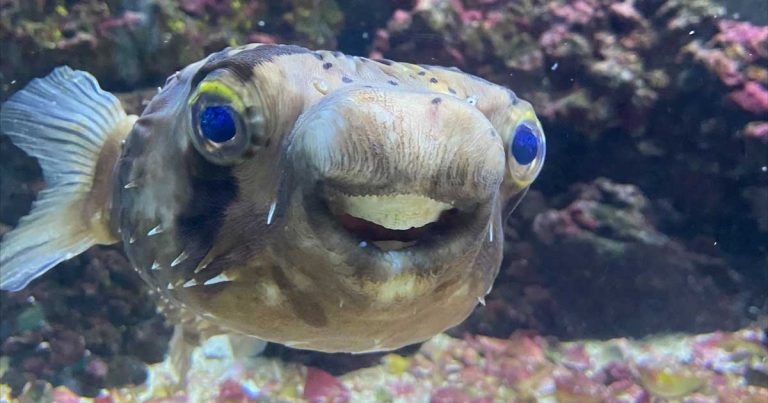26 Jan 2022
A porcupine pufferfish has recovered her appetite for life after a team at Sandhole Veterinary Centre filed down her overgrown beak during a delicate hour-long procedure.

A pufferfish whose beak had grown too large to let it eat has been saved by vets at a Kent practice after they carried out a rare procedure.
Goldie the porcupine pufferfish had been brought into Sandhole Veterinary Centre in Snodland, where vets filed down her teeth – known as a beak – to allow her to eat again.
RCVS specialist in zoo and wildlife medicine Daniel Calvo Carrasco trimmed down the overgrown beak, assisted by vet nurse Debbie Addison, after making specific preparations to care for the spined fish.
Dr Calvo Carrasco said: “They’re usually kept short naturally, as they’re worn down on their regular diet of hard-shelled foods, but while these foods are provided in her home environment, she is not as forthcoming in eating them as her other tank mates. As a result, her upper beak grew to the point where it was hindering her ability to eat effectively.
“Goldie was brought into the practice in a large watertight container containing water from her home tank and a licensed fish anaesthetic was placed into the water until she achieved a light plane of anaesthesia.
“To support her further, the water was oxygenated throughout. This meant she was still breathing nicely throughout, but was able to be held for brief periods out of the water without becoming too stressed.”
The porcupine pufferfish has a secondary defence mechanism that is provided by sharp spines, which radiate outwards when the fish is inflated, forcing staff at the Linnaeus-owned site to have to take the danger into consideration while operating.
Dr Calvo Carrasco added: “Debbie was able to hold Goldie in a damp towel to prevent her becoming too dry, while also ensuring she was protected if she did trigger her defence mechanism to inflate her body and activate her spines.
“It was during those brief periods out of the anaesthetic water that I was able to use a dental burr to cut through her upper beak and reduce its length by half.”
Once the procedure had been completed, Goldie was placed into a second large container with water from her home tank to recover from the anaesthetic.

Dr Calvo Carrasco said: “She responded well. Within 5 minutes, she was able to stay up right in the water and within 10 minutes she was back to happily swimming around.
“The whole procedure went swimmingly and was conducted in under an hour without any stress at all, and Goldie was back home and eating well within two hours.”